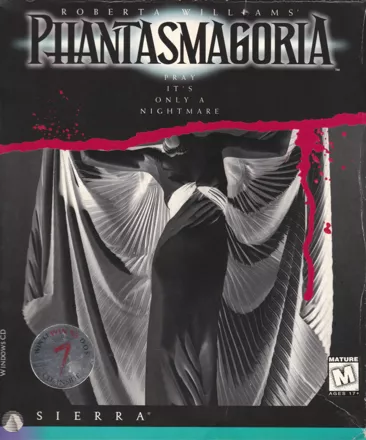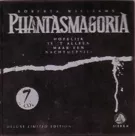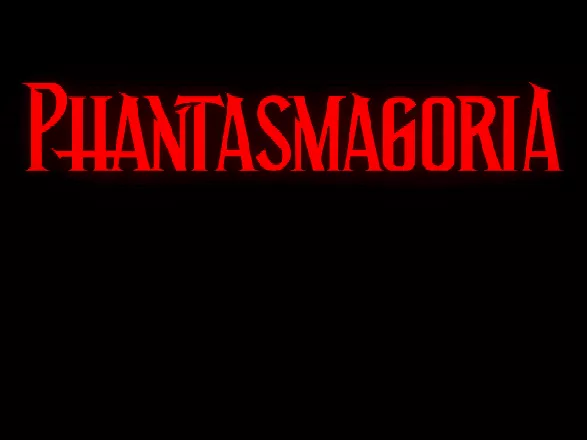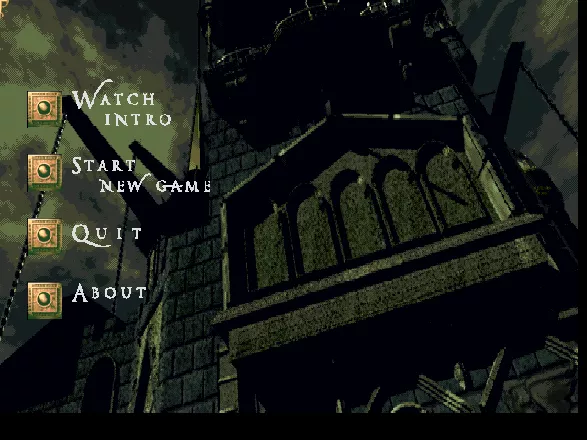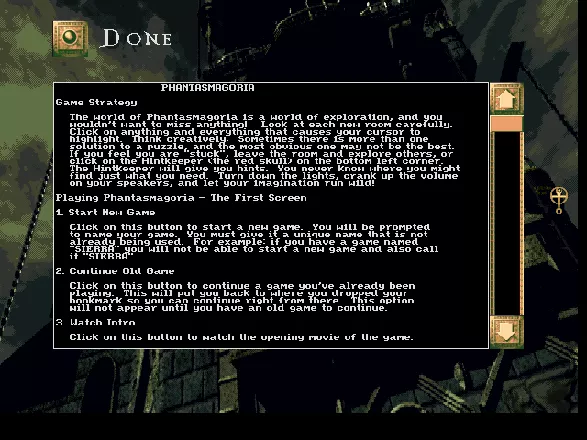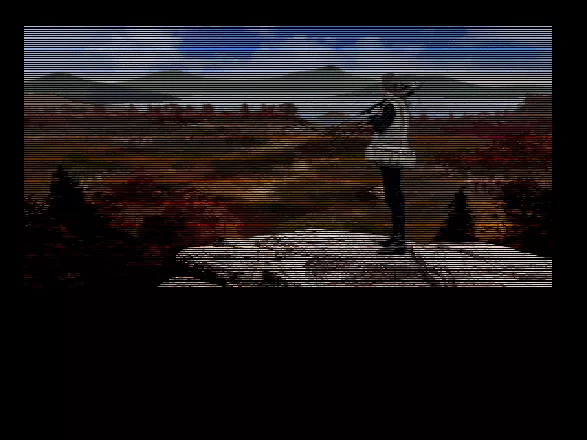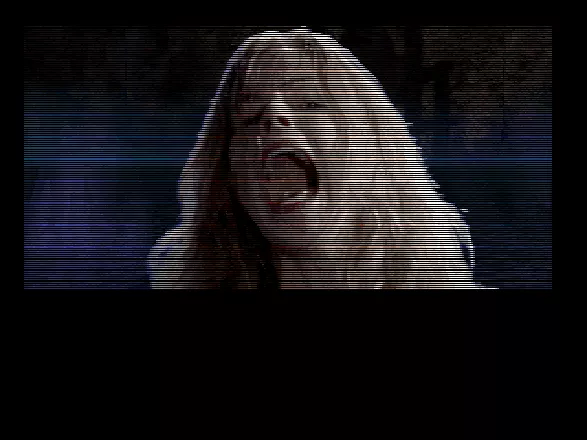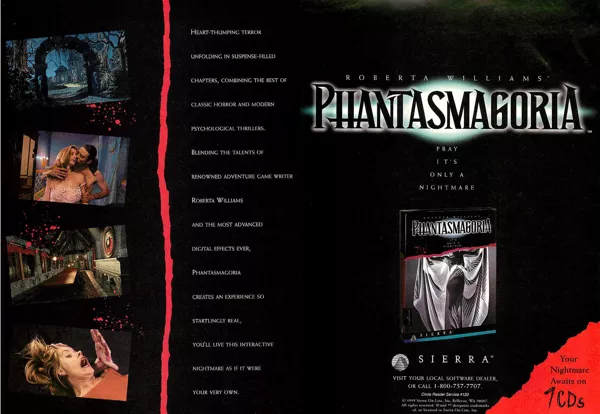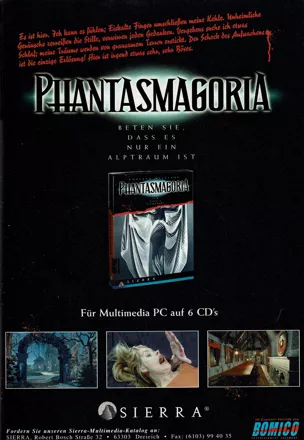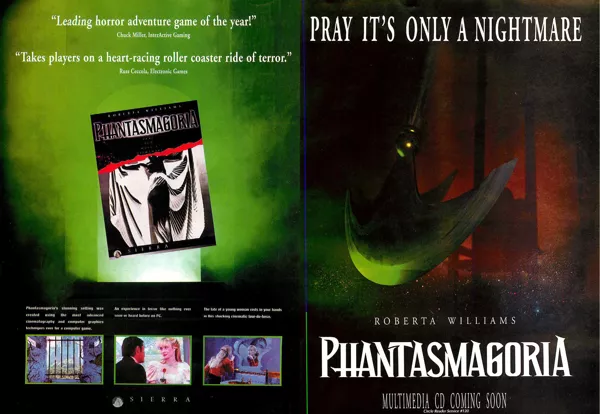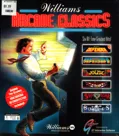Roberta Williams' Phantasmagoria
Description official descriptions
A writer named Adrienne Delaney has just moved into an old mansion with her photographer husband Donald. Shortly after moving in, Adrienne begins to experience horrifying nightmares and have odd encounters inside the creepy old abode. Furthermore, the house is having a severe effect on her husband, changing him for the worse. Adrienne must discover the secret of the house before the unknown force consumes her husband, and unravel the terrible events that have happened in the past.
Phantasmagoria is an adventure game that places heavy emphasis on full motion video for exposition and cutscenes at various junctures to advance the storyline. Adrienne is represented as a digitized character roaming around pre-rendered settings in the house. She inspects various rooms, finds items, adds them to her inventory, finds places to use the items, and triggers advancements in the plot.
Puzzle-solving element is present, though reduced compared to most other adventure games made by Sierra. There are seven chapters in the game, as well as a status screen that tracks the player's progress within the chapter. If the player happens to get stuck in the game, a talking skull icon who identifies himself as the hintkeeper can supply the player with hints on request. It is possible to start playing the game from any chapter.
Spellings
- ファンタズム - Japanese spelling
- 幽魂 1 - Taiwanese spelling
- 로베르타 윌리엄즈의 판타스마고리아 - Korean spelling
Groups +
Screenshots
Promos
Videos
See any errors or missing info for this game?
You can submit a correction, contribute trivia, add to a game group, add a related site or alternate title.
Credits (DOS version)
158 People (147 developers, 11 thanks) · View all
| Lead Design | |
| Writing / Dialogue / Story | |
| Director | |
| Producer | |
| Art Director | |
| Game Directors | |
| Lead Programming | |
| Music | |
| Movie Sequences Scored By | |
| Conductor |
|
| Musician | |
| Lead Vocal | |
| Sound Recording | |
| Additional Music | |
| [ full credits ] | |
Reviews
Critics
Average score: 66% (based on 32 ratings)
Players
Average score: 3.5 out of 5 (based on 118 ratings with 12 reviews)
Bad game, interesting interactive b-horror movie
The Good
I'd be lying through my teeth, if I'd claim Phantasmagoria as a good game. In fact I feel quite the opposite: as a game Phantasmagoria fails miserably thanks to poor design choices, but the game is not only thing Phantasmagoria is, as it is actually pretty entertaining, albeit some places rather poorly acted and written, interactive horror movie.
The story takes a couple of chapters to get going, but after it does it easily overcomes the poor design choices and keeps you entertained to the end. The game is actually pretty short, seasoned adventurers should go through it pretty fast, so in that sense it's a good way to spend an evening, if you are looking for b-horror horror.
The musical score is pretty good as well. It provides a nice atmosphere to the game and in FMV sequences the music is just superb.
The acting is mostly OK. The main cast does ham up pretty often, but luckily enough there's some good acting in the mix as well. Victoria Morsell does pretty good as the lead, despite she does have some cringe worthy dialogue. Robert Miano as Zoltan brings in good performance as well.
The Bad
The writing is a bit of a hit and miss. Some aspects of the game are well written, but some are just laughable bad. Some pretty sub par actors manage to enhance the poor quality of the script at places, but luckily enough nothing really important is missed even if you skip those parts.
Some poor design choices hinder the gameplay, such as unnecessary FMV segments in room transition or badly done conversations, which don't flow very naturally.
The graphics are mostly pretty ugly pre-rendered 3D. The FMV sequences look a bit better, but it's difficult to claim Phantasmagoria as a pretty game.
The Bottom Line
Phantasmagoria is a short and easy game. It does have very little merits as a good game, but as a b-movie it works surprisingly well despite it does have more than a couple of cliches in its sleeve of scare tricks.
It's not the best example of FMV games, but there's a lot worse candidates out there. Phantasmagoria is not a total failure, so if you're interested in FMV games you should check it out.
DOS · by tomimt (397) · 2012
Yikes! You scared the meaning out of my gameplay!..
The Good
When CDs started flooding the market in the first few years of the 1990's, many people thought the future of video games lied in interactive movies. The veteran adventure game designer Sierra became affected by this craze for a short while, and presented its own take on the new fashion: Phantasmagoria, a seven-disc extravagant monstrosity complete with live footage, digitized graphics, and stylized medieval-sounding choirs.
If getting scared is the only thing you look for in a horror game, then Phantasmagoria might not be as disappointing as it turned out to be for those who expected good adventure gameplay. Roberta Williams apparently had enough of innocent fairy tale storytelling in her King's Quest series and unleashed what must have been the darkest images concocted by her imagination onto this title. The game contains some of the most disturbing, unsettling scenes in the history of the medium - but that's not what makes it horrifying. Rather, it is the perpetual building of suspense, the long stretches of wandering preceding the brutality, during which not much is happening, but many things are foreshadowed, resulting in a convincingly ominous atmosphere.
All this is further enhanced by technology. The superbly detailed graphics are all digitized images, looking strikingly real and immersing you into the nauseating opulence of a haunted castle. The much-hyped video sequences may be too numerous and pointless in many cases, but they create a peculiar bond between you and the protagonist, as you watch her react to everything she notices in photorealistic detail. Those videos of the heroine adjusting her hair or curiously poking suspicious household items may be mundane, but that is exactly what makes the ensuing horror effects more prominent and long-lasting.
Exploration is accompanied by cozy MIDI music, but the movies boast symphonic soundtrack with occasional choir. The music that plays when you first load the game is singularly impressive: it is a real cantata written in over-saturated late 19th century style, which itself took some cues from medieval church music. The amalgamation of video, music, and interactivity are best displayed in the game's final chapter, which is the only one actually having what is commonly called interactive movie gameplay: you have to make the right choices while watching a tensely scripted sequence unfold.
The Bad
The guys from Sierra must have been too busy orchestrating the music score, filming the main actress opening drawers, and researching cases of psychotic behavior, because they seem to have forgotten all about the most important component of game design: the gameplay.
Indeed, stripped of its shiny appearance, Phantasmagoria turns out to be an impoverished, rudimentary adventure game, weak and pitiful like a fasting vegetarian cat. Suffice to say that the first King's Quest, produced eleven years prior by the same designer, is a more advanced and more interactive game. It is as if all progress in the genre achieved by Sierra and other developers in all those years has been negated.
Phantasmagoria is woefully easy. It has only a handful of what could be considered puzzles if they weren't trivially obvious item manipulations along the lines of "use key on door". The rest of the game is pretty much all aimless wandering. Like a Japanese adventure, Phantasmagoria is full of annoyingly awkward, ridiculously artificial scripting constituting the main obstacle in your path: if you knew exactly which particular room will magically trigger the next event, you'd be able to finish the entire game in a matter of minutes. All you do in the game during six chapters out of seven is wander around and click on things without any apparent reason, knowing that one of those meaningless actions will let you proceed.
Remember how endearingly fulfilling it was to try out stuff in adventure games and witness the game commenting it in the form of text descriptions? Well, there is nothing like that in Phantasmagoria. Instead of well-written commentaries the only feedback you'll get here are nondescript short movies. Even worse is the fact that nearly nothing in that lush, degenerate scenery can be interacted with. You enter a room full of furniture and trinkets, but the game only allows you to click on one or two spots. To put it simply, you hardly ever play Phantasmagoria; you watch it.
Unfortunately, even as a movie Phantasmagoria is not very good. There are interesting elements in the story, but otherwise the whole thing makes next to no sense. Adrianne, the main protagonist, prefers to stand coquettishly in front of a mirror and comb her hair instead of running the hell out of a house where bloody visions pop out of fireplaces and a tender pony-tailed husband can become an overacting homicidal maniac at any moment. Described as an intellectual, Adrienne nevertheless exhibits behavior traits of an insultingly submissive and oftentimes plainly stupid individual, neither displaying believable emotional or mental damages caused by the unspeakable horrors she witnesses, nor showing any traces of logic and willpower, walking from room to room like a zombie even when it becomes perfectly clear that the place is haunted.
Also, I found the amount of sickening scenes of torture and murder in the second half of the game excessive. The story would have been much more convincing if there were only one particular criminal act to investigate, with more background and evidence than we eventually receive for the several victims depicted in the game. The horror becomes grotesque and, inadvertently, almost cartoony as we begin to feel emotional numbness caused by the proliferation of violence.
The Bottom Line
No amount of lavishly decadent digitized decor and symphonic tracks with Latin lyrics can change the fact that Phantasmagoria is an overbloated, cheesy horror story with tiny bits of gameplay collapsing under the weight of multimedia aspirations. There is appeal and historic interest here, but it doesn't justify giving up on quality adventure gameplay Sierra has been delivering for years. For a better representation of the same technology and style, try the sequel or The Beast Within.
DOS · by Unicorn Lynx (181780) · 2016
Sierra opens the door of controversy
The Good
When people often think of Roberta Williams, they usually think of King's Quest, a series of adventure games established in the Eighties that had you doing such things as finding magic items, rescuing princesses, and dealing with evil wizards. What some people don't know is that Williams herself also developed non-KQ games, with some notable examples being The Colonel's Bequest, Mystery House, and Mixed-up Mother Goose. Her latest non-KQ title is Phantasmagoria, an interactive movie caught up in the same era where video game companies believed that they were the future of gaming.
Don Gordon (played by David Homb) is a magazine photographer who has an interest in 18th- and 19th-century architecture. His wife, Adrienne Delaney (Victoria Morsell), is a successful book writer who has started working on her new novel. When Don comes across a 19th-century dwelling on a remote island, he convinces Adrienne to buy it as it would be the perfect place to write her novel. But as soon as they take up residency, things take a turn for the worse. Adrienne finds out about the history of the mansion and discovers that its previous occupant was Zoltan “Carno” Carnovasch (Robert Miano), a magician who had a tragic past and was married five times to women who had either disappeared or died in grotesque ways. As the days go by, Adrienne realizes that she must confront Don in his psychotic state and deal with whatever is possessing him.
The front cover shows a grey image of a woman lying on a bed. When I saw the game in stores, I thought it was a bunch of ninjas doing something sinister. A look inside the box reveals seven black-covered CDs with a line of blood splattered across them and the number of the CD also written in blood. The front cover of the manual reflects the imagery on the box, and it covers installation and how to control the game, plus a very brief walkthrough at the end.
Phantasmagoria shares the same mechanics as King's Quest VII, with the game being split across multiple chapters. The player can select which one they want to start off with, but I don't recommend doing this as you will be playing the game out of sequence. The interface is the same, with one half the main screen, and the other reserved for your inventory, control panel, and the examine icons. New additions include the introduction of the hintkeeper and the ability to save your game at any point. The interface remains on the screen until the game's end credits are over.
Phantasmagoria was intended to be played by adults, and Sierra couldn't stress that enough. Two minutes in and there's a sex scene involving the main characters, as well as some nudity thrown in for good measure. During the game, I didn't have any problems watching short movies that had a decent amount of gore, but it was enough to cause controversy not just around the world, but in its home country. The introduction to chapter four features a rape scene, and the intensity of this scene made it uncomfortable to watch.
The opening menu features the same music as heard in the trailer for the game, and it sounds great. The choirs that can be heard also serve as incidental music for most of the movies featuring blood and gore. Each musical piece is unique to each chapter, and as you progress through the chapters, they get more intense. As far as I know, Phantasmagoria is the only Sierra interactive movie where you can choose what sound card you want to use for the game, not just Sound Blaster.
There are two highlights in this game. One of them is the story of how Carno became possessed, as told by an old man named Malcolm (Douglas Seale). The other is the “chase” sequence that occurs in the last chapter. I was impressed by Homb's performance that if Sierra's next Dr. Brain installment was an interactive movie, he would have made a perfect candidate. Also, the game records everything you do in this chapter and you can watch how you played it out. You could also have a little bit of fun with it. I got Adrienne to warm up before she makes her escape from Don.
The Bad
Before you start playing, you have to enter your name, and that name is used for just the one save slot. This means you cannot go back to an earlier point in the game where something is about to happen. I hate this mechanism, and I'm glad that it wasn't reintroduced to later Sierra games. Because of the way the interface is designed, you hardly could examine things and could only interact with them. (The exception is the portraits of Carno and his wives.) So basically you were guided through the game.
During the end credits, you hear a song called “Take a Stand” which is sung by Mark Seibert. I enjoyed listening to it, but it is inappropriate. It sounds like it was released in the Eighties, and it doesn't blend well with the game's theme
The Bottom Line
The concept for Phantasmagoria started in the late Eighties, but Roberta Williams waited a number of years for technology to catch up, and understandably so. Imagine what the game would look like if it was done in Sierra's old AGI engine. The game is a horror adventure game that generated a lot of controversy when it was released. The blood and gore wasn't actually real, and like a lot of Hollywood movies, many props and objects were put in good use to make us think it was.
Despite some problems with the game mechanics, the game is quite good, and it has a nice soundtrack filled with choirs that suit its intense scenes. I didn't have a problem with the 3D-rendered backgrounds, which was the norm for interactive movies back in the day. As I mentioned, I like the backstory involving Carno and his wives, and the aforementioned chase scene which was very well done and made Homb shine. Sierra released a sequel called A Puzzle of Flesh which has nothing to do with the original game and used actual locations around Seattle.
DOS · by Katakis | カタキス (43091) · 2017
Trivia
Absinthe
In the bar on the first floor there is a bottle of absinthe. As the game progresses, the bottle goes from full to nearly empty before it is removed from the bar altogether. Someone is drinking it.
Actors
Victoria Morsell, who plays Adrienne, and David Homb, who plays Don, started dating a week after they began filming together. The picture that sits on the night stand in the character's bedroom found a new home in the couple's living room after the game was finished.
Opening Theme
The opening theme for the game is called Consumite Furore, which translates to "Expend Your Rage," and was written by Mark Seibert based on an English text by Roberta Williams. The words in English and Latin are, respectively :
Come into this talisman || O Spirit of Darkness || Mighty Asteroth, I command you || And fill this stone with your rage || Fill it with your sulphurous powers|| Expend your angers on it || Those powers I will assume || I command you.
Venite in fascinum || O spiritus tenebrarum || Magne Asterothe, te iubeo || Et implete hunc lapidem vestro furore || Implete eum viribus sulfuratis vestris || Consumite eum iris vestris || Istas vires adsumem || Iubeo te.
Development
The game was finished by the latter part of 1994, and was ready for release, however Sierra chose to call back some of the cast and crew members for two additional sessions of filming. Filming initially took an additional month and, three months later, was resumed for another couple of weeks.
References
- The original title for the game was going to be Scary Tales but the name was changed to its current title during production. There is a directory for temporary files that the game installs called SCARY in honor of the early title.
- The office of Bob Thompkins, Adrianne's sleazy real estate agent, is decorated with posters of girls from another Sierra adventure game, Leisure Suit Larry 6.
Release(s)
- Due to strict censorship policies, Phantasmagoria was banned in Australia.
- The German version of the game was banned in Germany on March 31st, 1998.
Awards
- Power Play
- Issue 02/1996 – Biggest Disappointment in 1995
Information also contributed by MrBucket, phlux, Straw Hubert and Zovni.
Analytics
Upgrade to MobyPro to view research rankings!
Related Sites +
-
Hints for Phantasmagoria 1
Susan Niles wrote these hints for the Universal Hint System that can be viewed on the web. They may help you solve the game. -
IGCD Internet Game Cars Database
Game page on IGCD, a database that tries to archive vehicles found in video games. -
Review of Phantasmagoria Memorial by Anthony Larme
Very good site about Phantasmagoria, lots of details, pictures and secrets. -
Wiki
Phantasmagoria on Wikipedia
Identifiers +
Contribute
Are you familiar with this game? Help document and preserve this entry in video game history! If your contribution is approved, you will earn points and be credited as a contributor.
Contributors to this Entry
Game added by Derrick 'Knight' Steele.
SEGA Saturn added by roushimsx. Windows 3.x added by MAT. Macintosh added by Jeanne.
Additional contributors: Jeanne, Ajan, roushimsx, formercontrib, ケヴィン, Zeppin, Paulus18950, Cantillon, lee jun ho, Patrick Bregger, Victor Vance, ZeTomes.
Game added March 27, 2000. Last modified February 21, 2024.
